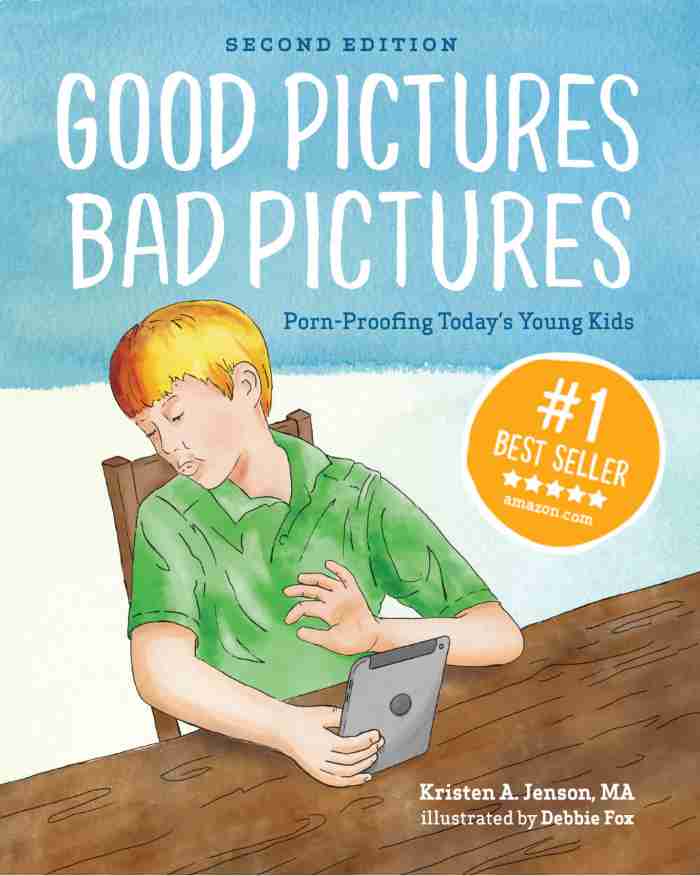.webp)
.webp)
3 Important Reasons Why Kids Should NOT Be Taught 'Consent'
Can children really give their “consent” for allowing physical touch? Or can using this term backfire with unintended consequences that make kids even more vulnerable to sexual exploitation? Would another term–boundaries–be safer and even more appropriate for kids?
.webp)
We’re seeing this idea of kids giving consent everywhere. Consent is the new buzz word for personal safety, catapulted by the Me Too movement. Even board books for toddlers talk about consent. Good intentions with bad consequences.
To be clear, each year I teach millions of parents about both body and digital safety via my Defend Young Minds website, social channels, speaking events, and my Good Pictures Bad Pictures books. But in the past few years, I’ve seen well-meaning people use the term consent to teach body safety for kids.
It’s time I speak up and share why I think consent is a slippery slope for our children’s safety.
Let me say that I’m totally in favor of the use of “consent” for adults. Giving permission for physical or sexual interaction is something an adult is capable of doing. They generally have the brain maturity to weigh the risks, benefits and ethics to make their own decisions. They can say yes…or no.
But it’s not the same for kids. There should be no option for kids consenting or saying yes to sexual behavior or sexual touch.
And what about unintended consequences? If kids feel like they can give consent for sexual touch, then does that make it OK for adults to be attracted to kids? It's a slippery slope that will only hasten the legitimization of “Minor-Attracted Person” as a valid sexual orientation.
Will you join me in standing up for kids to say it’s wrong to sexualize children or even hint that they can give their consent for sexual touch?
I believe the word “boundaries” is the best age-appropriate term when it comes to teaching kids body safety. Let me give you three reasons why we should teach kids to use boundaries instead of giving consent.
#1. Children need guidance, not responsibility
When it comes to protecting children from sexual abuse, kids are ultimately not responsible. Adults are. We can teach children to be safe, much like we teach them to cross the street safely. But we can’t make them responsible because they are not developmentally able to protect themselves.
It's important for kids to understand that they didn't do something wrong if they are taken advantage of and harmed by someone else.
When we use an adult term like “consent” with kids, what we’re doing is heaping upon them an adult burden. We’re actually giving them the option to give consent, and that can backfire. For example, what if a child says, “I gave him my consent to touch my privates. It’s my body and I can give my consent!” Outcomes like this show the danger of giving kids responsibility that is not age-appropriate.
Related: 4 Body Safety Rules to Protect Kids Ages 5-10
#2. Consent is not an option for kids
The definition of consent means to say yes. Children are simply not developmentally ready to give consent and say yes to sexual activity. Children should not be sexualized in any way. If they are sexualized, we call this child sexual exploitation or abuse.
We shouldn’t even be putting the word consent into their vocabulary–even if we think it should always be used to say NO. It’s like adding Vodka to the list of available beverages at the lunchroom cafeteria. It shouldn’t even be a choice.
Teaching children to use the term consent can lead to misunderstandings when applied to more dangerous situations. For example, children may be taught they can give consent to hug a family member or not. This seems pretty innocuous.
As I mentioned above, the problem arises when this term of consent is applied in a predatory situation. What if a young child is groomed so well that they want sexual touch by a predator? If they are taught using the term “consent,” children may mistakenly, even subliminally, be open to saying yes or consenting to sexual touch. For example, what if a child says, “I like it when I snuggle with Uncle Kenny in bed. It’s my body and I can give my consent!” Believe me, this could happen and it’s exactly what child predators would want.
Related: 5 Body Safety Rules Every 5-Year-Old Should Know
#3. Boundaries empower children to say NO
When we teach children about boundaries, they can understand what is appropriate and what isn't. Boundaries empower children without burdening them with the responsibility of granting or denying consent.
This approach not only keeps children safer but also ensures that they understand their rights without placing undue responsibility on their young shoulders.
When children have a clear understanding of boundaries, they know exactly what is okay and what is not.
- If someone crosses those boundaries, children are equipped to take appropriate action, such as telling a trusted adult.
- Importantly, children understand that it is never their fault if someone violates their boundaries.
Empowering kids with information
Protecting children from sexual abuse involves providing them with essential information. Teach kids about the three red flags of sexual abuse in 3 Big Red Flags of Sexual Abuse so they recognize grooming situations.
One critical safety skill is knowing how to reject pornography. Because pornography is a predator’s number one grooming tool and porn also grooms kids to act out sexually on other kids, children are safer from sexual abuse when they know how and why to reject pornography. Use Good Pictures Bad Pictures to start and continue these protective conversations.
Related: 5 Proven Ways Porn Harms Kids that No One Talks about
[[CTA]]
Boundaries are better for kids than consent
To sum up, boundaries is a better, stronger term for the following reasons:
- Boundaries are more age-appropriate. Consent overloads children with a level of responsibility they are not capable of handling.
- Consent can backfire. Teaching children the concept of consent could backfire when they are groomed by a predator into giving consent to sexual touch that is actually sexual abuse.
- Boundaries empower kids to say NO to sexual touch. When kids are taught boundaries, they learn safe, appropriate behavior and responses without burdening them with an adult option that can backfire.
A personal story
My parents were plagued with alcohol abuse. As a result, not only were we put in some dangerous situations, but in order to survive we learned to take on much more responsibility than we were developmentally ready for. In fact, “adult children of alcoholics” have a specific set of issues they have to overcome to be mentally and emotionally healthy. And believe me, it’s not easy.
Maybe that’s why I’m so passionate about teaching children boundaries and not burdening them with the over responsibility of giving “consent.”
Please teach your children about safe boundaries and leave the term consent for adults. Your kids will be safer!
.webp)


Good Pictures Bad Pictures
"I really like the no-shame approach the author takes. It's so much more than just 'don't watch or look at porn.' It gave my children a real understanding about the brain and its natural response to pornography, how it can affect you if you look at it, and how to be prepared when you do come across it (since, let's face it... it's gonna happen at some point)." -Amazon Review by D.O.
.webp)
.webp)





